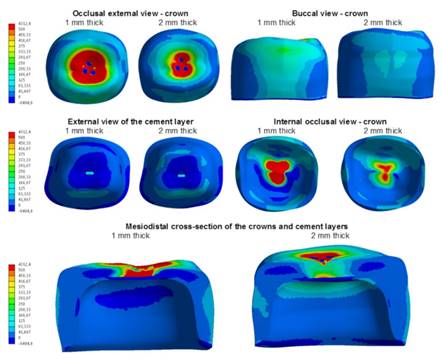Abstract
In the RLT (Rapid Layer Technology), veneering ceramic and framework are fabricated by computer-aided design/computer-aided manufacturing (CAD/CAM) and then cemented to obtain the restoration. This study aimed to evaluate the effect of the thickness of veneering ceramic manufactured by the RLT technique on the fracture resistance (FR) of bilayer crowns with zirconia frameworks. Twenty zirconia frameworks and twenty feldspathic posterior crowns with two different veneering ceramic occlusal thicknesses (1mm=TF1; 2mm=TF2) were manufactured using CAD/CAM system. The specimens were luted to an epoxy resin abutment with resin cement and mechanically cycled (200N and 4.5×105 Pa, 37°C, 2×106 cycles, 3Hz). The FR test was performed (10kN, 0.5mm/min), and the specimens were analyzed in a stereomicroscope. For the stress analysis (finite element analysis, FEA), a 10kN load was equal to the in vitro test, and the principal stress was evaluated. The FR data were analyzed by Student’s t-test and Weibull's analysis. The thickness influenced the FR of bilayer crowns. The FR was higher in the TF2 than in the TF1 group. The TF2 group presented the highest characteristic strength compared to the group TF1. The predominant type of failure was delamination. The FEA showed higher stress concentrations below the loading application point at the veneering cement interface in the 1-mm-thick model. The bilayer crowns manufactured using the approach of 2mm of veneering ceramic promoted higher FR compared to the group with 1mm veneering ceramic. Also, the FEA showed that the veneer ceramic thickness has an effect on stress distribution in zirconia-based bilayer crowns.
Key Words:
zirconia; porcelain; ceramic; finite element analysis

 Thumbnail
Thumbnail
 Thumbnail
Thumbnail
 Thumbnail
Thumbnail
 Thumbnail
Thumbnail



